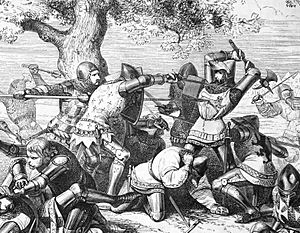Robert Bemborough facts for kids
Sir Robert Bemborough (died 1351) was a knight from the Middle Ages. He led one side, called the Montfortists, during a famous fight known as the Combat of the Thirty. This was a special battle arranged between thirty knights from each side. It happened during the Breton War of Succession, which was a big fight for control of a region called Brittany. Bemborough was killed during this battle.
The Combat of the Thirty became very famous. People who wrote about history often described Bemborough as a perfect example of a knight. He was seen as someone who followed the rules of chivalry, which meant being brave, honorable, and polite.
Contents
The Famous Battle: Combat of the Thirty
Bemborough was in charge of the Montfortist group. They controlled a town called Ploërmel. The Montfortists were mostly supported by English knights. A knight named Jean de Beaumanoir challenged Bemborough to a fight. Beaumanoir was the leader of Josselin, a nearby castle controlled by the Blois group, who were supported by the French.
At first, it was supposed to be a one-on-one duel between Bemborough and Beaumanoir. But then, Bemborough suggested a bigger fight. He proposed that twenty or thirty knights from each side should battle. Beaumanoir liked this idea a lot! They agreed to fight in a field with an oak tree, halfway between their two castles.
Bemborough is said to have spoken famous words before the battle:
Let us fight there and do so much that people will talk about it in the future, in castles, palaces, and everywhere else in the world.
This quote shows how important honor and fame were to knights back then.
Who Was Sir Robert Bemborough?
It's a bit of a mystery where Sir Robert Bemborough came from. People aren't sure if he was English or German. His name was also spelled in many different ways, like "Brandebourch," "Bembro," or "Brembo." Sometimes his first name was Robert, and sometimes Richard.
Some old writers said he was a German knight. But many historians today doubt this. One writer thought his name might have come from the Breton language, where "Pennbrock" sounds like "badger-head." This became a funny nickname for him.
Other historians believe he was probably English. Some think his name might have come from a place called Bromborough in England. It seems there was a family named Bembro who served as knights in Brittany during the war.
The End of the Battle: Bemborough's Death
During the battle, Bemborough was killed. The fight lasted for several hours. After a while, both sides were tired. They took a break to eat and bandage their injuries. When the battle started again, Bemborough was hurt and then died.
After Bemborough fell, another German warrior named Croquart took over. But in the end, Bemborough's side lost the battle.
One dramatic story from a Breton historian tells us more about his death. It says that a squire, Alain de Keranrais, and Beaumanoir's friend, Geoffroy du Bois, killed Bemborough. This happened while they were defending Beaumanoir from Bemborough, who had just promised to capture Beaumanoir.
The story says that Alain de Keranrais shouted at Bemborough and then struck him in the face with his spear. Bemborough fell. As he tried to get up, Geoffroy du Bois threw his axe into Bemborough's chest. Bemborough died right there.
How People Remembered Bemborough
Different stories tell us different things about Sir Robert Bemborough.
- A Chivalrous Knight: The writer Froissart said that both Bemborough and Beaumanoir were perfect examples of chivalry. They fought for honor and glory, not for money.
- A Villain: But a popular song from that time, called La Bataille de Trente Anglois et de Trente Bretons, showed Bemborough as the leader of foreign bad guys who were hurting the local people. In this song, Beaumanoir was a hero defending his people. This idea became very popular in Brittany and later in France.
- A Vengeful Soldier: Another writer, Pierre Le Baud, wrote in 1480 that Bemborough was a soldier who wanted to get revenge for another English leader's death. He described Bemborough as cruel.
- A Tough Soldier: The famous writer Arthur Conan Doyle (who wrote the Sherlock Holmes stories) also wrote a historical novel called Sir Nigel. In his book, Bemborough (called Richard of Bambro) is a tough, experienced soldier. He's described as a "rugged Northumbrian" who was used to hard battles. Doyle said that Bemborough was "hated" by the local people because he made them pay money. But in the battle, he acted honorably. He even shook hands with Beaumanoir before the fight! In Doyle's story, Bemborough died because he didn't close his helmet visor properly.
These different stories show how people's views of historical figures can change over time.



